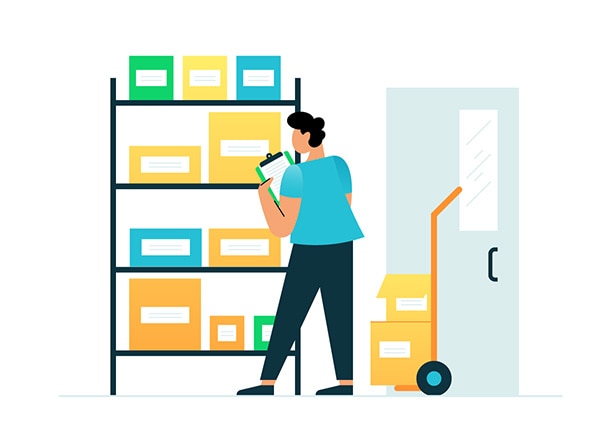The quickest way to lose sales to a competitor is to be out of stock when a potential customer is ready to make a purchase. Product availability is increasingly important, with studies showing 65% of customers prefer to purchase with retailers that offer a quick transaction process.
Effective inventory replenishment can prevent this from happening. By keeping an eye on stock levels and moving products along the supply chain, inventory replenishment ensures there’s sufficient stock to meet demand and increase a company’s sales.
What is inventory replenishment?
A basic definition of inventory replenishment (or stock replenishment) is refilling stock for products or materials that have been used or sold.
In practice, this can be moving inventory from a supplier to the company’s warehouse or from reserve storage to the active pick area. No matter what the inventory is—whether raw materials or finished products—replenishment ensures enough inventory allocation to fulfill all immediate customer orders.
How inventory replenishment works
Although inventory replenishment is largely a logistics operation, it also involves sales analysis, demand forecasting, and warehouse management.
When a specific product runs out, it doesn’t always mean it should be replenished. The company may decide to discontinue the product due to slow sales or only plan to carry it for the current season. In fact, inventory replenishment should only be done if there’s a perceived market need for the product.
Once a market demand is confirmed and inventory levels reach a certain reorder point (more in the next section below), an employee places an order for replenishment.
Four inventory replenishment methods
There are several available methods when it comes to replenishing inventory. The best one to use depends on the type of business and how quickly its product turns over. Here are four main inventory replenishment strategies.
Reorder point formula
With the reorder point formula, a company determines the minimum inventory stock level for when a specific product should be replenished. For example, a retailer can start with 2,000 ceiling fans and set a reorder point when its inventory reaches 550 fans.
Each product or SKU should have its own reorder point based on previous sales data and should be revisited if there’s any perceived shift in demand.
The reorder point formula is:
Reorder point = (Average daily usage rate * lead time) + safety stock
The average daily usage rate represents the number of products sold or used each day, while the lead time indicates the number of days it takes for the supplier to deliver the reorder to the company. Safety stock, or just-in-case inventory, is the inventory a company keeps to meet any unforeseen increases in demand.
In the above ceiling fan example, if a company sells 100 fans a day, has a lead time of five days, and maintains a safety stock of 50 fans, its reorder point is 550, based on the calculation below:
550 = (100 * 5) + 50
The reorder point method enables a business to maintain the lowest inventory levels, effectively reducing the required warehouse space and tied-up cash flow while still ensuring it meets customer demand.
Top-off replenishment method
The top-off replenishment method (also called lean time replenishment) restocks inventory during slow fulfillment periods. It works well for companies that deal with fast-moving inventory and relatively short picking windows, as it takes advantage of times when there’s not much movement in the pick location.
When it’s time for inventory to be topped off, each pick location is restocked to its maximum levels. Using this method, a company can make the most of downtimes while not affecting efficiency during peak periods.
Periodic replenishment method
Inventory is restocked at set intervals with the periodic replenishment strategy, say at the end of every month or quarter. Even if inventory levels are running low, using the periodic method, a company won’t restock until the predetermined date. If inventory levels still look good at checking, then no reorders are placed.
Demand replenishment method
The demand replenishment strategy is a straightforward, ad-hoc method of replenishing inventory. A company reorders inventory based on market demand and what it needs to fulfill orders.
While the demand replenishment strategy is relatively simple, it also requires looking at previous season sales and demand forecasting. It’s also recommended that a company hold some amount of safety stock to buffer against any unexpected fluctuations or prepare for holiday or seasonal demand.
Four benefits of effective inventory replenishment
Inventory replenishment guarantees a company can fulfill customer orders and continue to generate revenue. Having an effective strategy in place creates standardized ways of working across all areas of inventory management. Here are the other benefits that come with effective inventory replenishment:
Prevents stockouts and backorders
Inventory stockouts and backorders translate to lost sales and can eventually lead to customer attrition and a negative brand reputation. Not being able to fulfill orders on time due to unavailable inventory can be avoided with effective inventory replenishment.
No matter what method a company uses, actively addressing low inventory levels can prevent any stockouts and sales drops.
Safeguards from overstocking
Conversely, without inventory replenishment systems in place, companies tend to overstock inventory as a way to always fulfill a customer order. However, holding too much inventory requires an unnecessarily high amount of resources, including increased storage space and additional labor. Overstocking can also leave companies with large quantities of unsold, dead stock products.
An inventory replenishment strategy starts with understanding customer demand and market changes, and then uses this to determine optimal inventory levels and reorder points.
Reduces reorder and shipping costs
Companies without an inventory replenishment strategy usually place their orders at random, often paying extra for expedited delivery. Replenishing inventory at regular schedules enables a company to negotiate with suppliers for better rates or even consolidate shipments to save on costs.
When a regular replenishment schedule is established, companies can create optimized routes that move inventory closer to the customers as needed.
Improves customer experience
The ultimate goal of maintaining inventory levels is to be able to fulfill customer orders the moment they’re placed. A formal inventory replenishment process ensures a company has the right products available at the right time while keeping resources and excess waste under control.
By replenishing inventory following demand, a company can give customers a good experience and build a good reputation in the market.
Four inventory replenishment best practices
An effective replenishment strategy requires proper inventory planning and implementation. The following are some best practices that are proven to help companies better manage their inventory:
Draw from inventory and sales data
The best inventory replenishment strategy is based on actual company data. Insights from inventory turnover, sales orders, and inventory forecasts should be drawn for each product. Knowing how fast each product moves and how much profit it generates helps a company arrive at the optimal inventory levels and reorder quantities.
Develop comprehensive inventory strategies
Inventory replenishment is one part of overall inventory management. It works alongside inventory tracking, warehouse management, supply chain strategy, and several other areas.
Depending on a company’s sales model and industry, each function should be tailored to build the most effective inventory strategy.
Refine the replenishment process with suppliers
Once a company determines its inventory restock levels and minimum order quantities, the next step to consider is how to best work with its suppliers. Here are some questions to ask:
- How much lead time should be expected between restock order to delivery?
- Are there any minimum or maximum order quantities required for every order?
- Can the minimum order be divided into smaller shipments within a specific period?
- Does the supplier offer bulk discounts that might make certain restock levels more profitable?
Automate key steps in the replenishment process
There are several factors to consider when replenishing inventory. Keep things running smoothly by automating routine steps with dedicated inventory management software from QuickBooks Enterprise.
Some tasks to consider for automation include creating sales and forecast reports, calculating reorder points, and tracking inventory shipments across warehouses.
This allows easy access to real-time data and can help facilitate alignment and coordination across different teams.
By removing many of the manual steps in inventory replenishment, inventory software frees up time to focus on more impactful strategic decision-making.
Final thoughts
Effective inventory replenishment helps companies anticipate demand and fulfill customer orders, without adding unnecessary expenses.
Being aware of optimal inventory levels and when it’s best to restock products or supplies can help a company achieve operational efficiency and competitive advantage.
Companies can improve their inventory replenishment goals with QuickBooks Enterprise, which provides all the tools needed to track real-time stock levels, manage order fulfillment, and gain insights into different opportunities to increase profitability.














